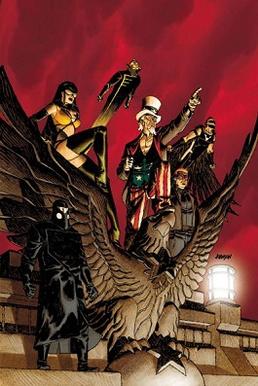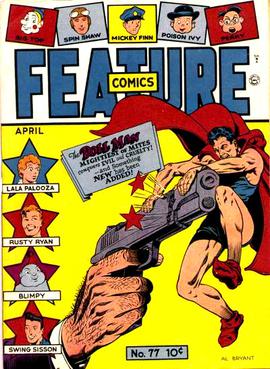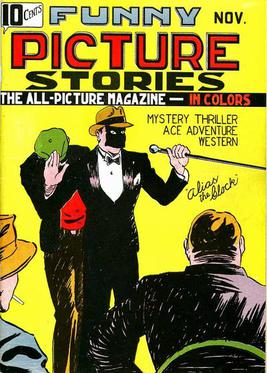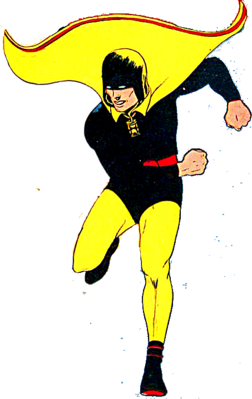
The Justice Society of America (JSA) is a superhero team appearing in American comic books published by DC Comics. It was conceived by editor Sheldon Mayer and writer Gardner Fox during the Golden Age of Comic Books. It first appeared in All Star Comics #3, making it the first team of superheroes in comic books. Its original members were Doctor Fate, Hourman, the Spectre, Sandman, Atom, the Flash, Green Lantern and Hawkman.

The All-Star Squadron is a DC Comics superhero team that debuted in Justice League of America #193 and was created by Roy Thomas, Rich Buckler and Jerry Ordway. Although the team was introduced in the 1980s, its self-titled series took place in the 1940s, retroactively inserting their narratives into the fictional history of the DC Comics superheroes. The team included many of DC's Golden Age era characters, new characters, and other World War II superheroes that DC did not own during the 1940s but later acquired. The name "All-Star Squadron" was creator Roy Thomas' reference to All Star Comics, the series that introduced the Justice Society of America, the first comic book superhero team.

The Freedom Fighters is a superhero team appearing in American comic books published by DC Comics. The original six characters were the Black Condor, Doll Man, the Human Bomb, the Ray, the Phantom Lady, and Uncle Sam. Although the characters were created by Quality Comics, they never were gathered in a group before being acquired by DC. The team first appeared in a Justice League of America/Justice Society of America team-up, which ran in Justice League of America #107–108, written by Len Wein and drawn by Dick Dillin. Their own ongoing series premiered with Freedom Fighters #1, written by Gerry Conway and Martin Pasko, and drawn by Ric Estrada.

Doll Man is a superhero first appearing in American comic books from the Golden Age of Comics, originally published by Quality Comics and currently part of the DC Comics universe of characters. Doll Man was created by cartoonist Will Eisner and first appeared in a four-page story entitled "Meet the Doll Man" in Feature Comics #27. He was Quality's first super-powered character.

Courtney Elizabeth Whitmore, known as Stargirl, is a superhero created by Geoff Johns and Lee Moder who appears in American comic books published by DC Comics. The character's name, appearance, and personality were patterned after Johns' 18-year-old sister Courtney, who died in the explosion of TWA Flight 800 in 1996.

Adventure Comics is an American comic book series published by DC Comics from 1938 to 1983 and revived from 2009 to 2011. In its first era, the series ran for 503 issues, making it the fifth-longest-running DC series, behind Detective Comics, Action Comics, Superman, and Batman. The series was revived in 2009 through a new "#1" issue by artist Clayton Henry and writer Geoff Johns. It returned to its original numbering with #516. The series ended again with #529 prior to a company-wide revision of DC's superhero comic book line, known as "The New 52".
Miss America is a superheroine from the DC Comics Universe. She was first created by Quality Comics in Military Comics #1, and was carried over to DC Comics when they purchased Quality in the 1950s. While the original Golden Age character is in public domain, the subsequent versions created by DC Comics are not.

Phantom Lady is a fictional superheroine appearing in media published by Quality Comics and DC Comics. She was created by the Eisner & Iger studio, one of the first to produce comics on demand for publishers. The character's early adventures were drawn by Arthur Peddy.

The Human Bomb is a fictional superhero published by DC Comics. He first appeared in Police Comics #1, and was created by writer and artist Paul Gustavson.

The Clock is a fictional masked crime-fighter character created in 1936, during the Golden Age of Comic Books. He was the first fully-masked hero to appear in American comic books.

Air Wave is the name of three superheroes appearing in American comic books published by DC Comics. The first two were active in the Golden Age of Comic Books. The third appears in comics in the 21st century.
Firebrand is a name of different characters appearing in American comic books published by DC Comics.

Congorilla, originally a human character known as Congo Bill, is a superhero appearing in comic books published by DC Comics and Vertigo Comics. Originally co-created by writer Whitney Ellsworth and artist George Papp, he was later transformed into Congorilla by Robert Bernstein and Howard Sherman. The character first appeared in More Fun Comics #56.

Neon the Unknown is a fictional superhero from the Golden Age of Comic Books created by Jerry Iger for Quality Comics. Neon first appeared in a story penciled and inked by Lou Fine in Hit Comics #1 and was featured on the cover. His stories ran in issues 1–17.
Red Torpedo is the name of two fictional characters, one originally published by Quality Comics and another currently owned by DC Comics. The original is a superhero named Jim Lockhart while the second is an android created by T. O. Morrow. Jim Lockhart debuted in Crack Comics #1.

The Invisible Hood is a fictional superhero in the DC Comics Universe. He was originally owned by Quality Comics, but was later acquired by DC Comics, along with other Quality characters. He first appeared in Smash Comics #1, and was created by Art Pinajian, who illustrated the story under the pseudonym "Art Gordon".

Jester is a fictional character, a Golden Age superhero created by Paul Gustavson and published by Quality Comics. He first appeared in Smash Comics #22. Like most of Quality's characters, the Jester was later purchased by DC Comics and incorporated into their universe. Though little used by the company, he appeared in All-Star Squadron #31 and #60 and Starman #46. The character's last Golden Age appearance was in Smash Comics #85.

Sylvester Pemberton, alternately known as The Star-Spangled Kid and Skyman, is a superhero in the DC Comics universe. Sylvester first appeared in Star Spangled Comics #1 and was created by Jerry Siegel and Hal Sherman.

Hourman is a fictional superhero appearing in comics published by DC Comics. He is known as the original Hourman. He was created by writer Ken Fitch and artist Bernard Baily in Adventure Comics #48, during the Golden Age of Comic Books. He continued to appear in Adventure Comics until issue #83.

Charles McNider is a fictional superhero in DC Comics. The character appeared for the first time in All-American Comics #25.


















